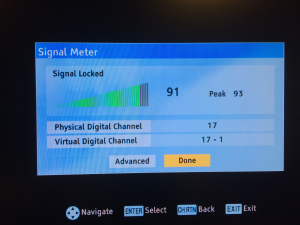
Outdoor antennas are the best and seldom have issues, but this article will address indoor antennas since they are the most popular.
You may not have a satisfying experience if you stick your antenna in a corner and expect it to work fine for all signals. As a matter of fact, a corner might be the worst place to put it, depending on wall thickness and materials used for siding on your house. Finding the best place for your antenna can be a bit tricky, but not impossible using the tools built into most TV sets today. The Signal meter is your best friend for locating the antenna and is usually in a setup menu, or buried at the bottom of the channel menu. It’s extremely handy and actually, it’s the only way to ensure your antenna is adjusted properly. Some meters measure signal quality and some display signal strength. They are vastly different, but the procedure is the same and the indicator is no different between them. Getting to this menu display is the first thing you should do when you think the antenna needs adjusting.
Follow these steps carefully to adjust your antenna!
Anytime you are setting up a new TV or planning to re-scan the channels, the first thing to check in the menus is to make sure it is set to AIR and not CABLE! Some sets come with two inputs labeled AIR and the other labeled CABLE. Do not plug your antenna into the CABLE input as they have different frequencies and you may not receive any off air signals. Once you have the antenna connected and are set to AIR, find the signal meter menu.
Find The Signal Meter
 Here’s a picture of a Toshiba TV in my office I use to monitor the station. Once you find this meter on your TV, I recommend writing down the readings for every channel so you can tell if you made things better, or worse. Regardless whether your TV is displaying signal strength or signal quality, the goal is to have the meter indicate the highest reading in bars, like this meter, or percentage as some meters may display. Once the antenna is peaked, it should be fairly stable. If the readings vary widely, or drop to zero, keep adjusting the antenna until you get a steady reading. Making sure the signal is peaked will prevent things like breakup when it rains, or someone walks across the room near the antenna. The goal is to not fall off “the digital cliff”, which is a level that may show some signal indication, but not be able to lock onto the signal. “The picture just drops out and shows no signal” really shouldn’t happen often. Peaking this meter ensures it won’t.
Here’s a picture of a Toshiba TV in my office I use to monitor the station. Once you find this meter on your TV, I recommend writing down the readings for every channel so you can tell if you made things better, or worse. Regardless whether your TV is displaying signal strength or signal quality, the goal is to have the meter indicate the highest reading in bars, like this meter, or percentage as some meters may display. Once the antenna is peaked, it should be fairly stable. If the readings vary widely, or drop to zero, keep adjusting the antenna until you get a steady reading. Making sure the signal is peaked will prevent things like breakup when it rains, or someone walks across the room near the antenna. The goal is to not fall off “the digital cliff”, which is a level that may show some signal indication, but not be able to lock onto the signal. “The picture just drops out and shows no signal” really shouldn’t happen often. Peaking this meter ensures it won’t.
Adjust the antenna
While looking at the signal meter, slowly adjust the antenna. I should stress the word SLOWLY, as the meter does not react in real time, meaning it may take a second or so before it updates to show if it the signal is better or worse, and only make small adjustments. Your body can react to the signals, so step away a few feet to see if the signal changes. Just keep repeating until you find the peak. That means as you turn the antenna, it gets better, better, then starts falling lower. Keep going until it completely goes out and then back it up to the position it had the peak. Step back away from the antenna and then click through all the channels to make sure everything is working fine.
Now What?
If you are getting all the channels, congratulations! You did it!
But what if it still breaks up, or displays “no signal”? Again, look at the signal meter.
Does it show any signal at all? If so, then move the antenna a few feet left or right to see if that resolves it.
Look for another spot for the antenna, such as near a window to see if that helps. Thick walls can cause issues as well as metal siding and bricks.
Can you place the antenna higher, like on a bookshelf? Sometimes a little height will help a lot.
What Should You Look For?
RF has not really changed since TV was invented, except of course, the type of signal that is riding on the RF. (Radio Frequencies) Modern antennas are better designed than older antennas, but I talked with a Lady in Stantonsburg in Wilson County that is still using her old “rabbit ears” and does not have any problems with it.
RF still travels in straight lines. It does not bend well over hills, so if you live behind a hill your only option may be an outdoor antenna around 30′ high. The signals do bounce, much like a ball on a pool table hitting the bumpers. Trees can bounce and absorb signals and buildings cause all kinds of issues. (Glass on buildings are treated with an aluminum coating and can reflect signals)
Even the atmosphere causes strange bounces and signals could be flying over your head one day, and beamed down to your antenna the next.








